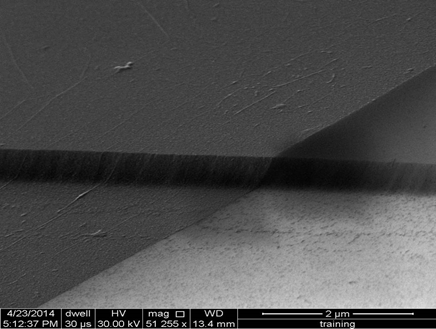05/03/2015
Ajayan, o criador das camadas finas, fortes e versûÀteis
Especialista em nanomateriais vem û 38ôˆ. RASBQ falar sobre camadas atûÇmicas de duas dimensûçes e suas muitas aplicaûÏûçes

|
|
"If effectively used, chemistry can help in many of the social/environmental issues facing us such as poverty, water, disease, pollution etc."
|
Imagine uma folha de papel, a mais fina que vocûˆ conseguir. Agora imagine uma pelûÙcula muito mais fina que esta folha. TûÈo fina que nûÈo se pode dividi-la em duas camadas. Esta pelûÙcula formada por uma camada atûÇmica ûˋ forte, robusta e pode ser facilmente manejada, como peûÏas de montar de brinquedos de crianûÏa. As chamadas camadas atûÇmicas de duas dimensûçes (2D) sûÈo o objeto das pesquisas do engenheiro metalû¤rgico, doutor em Ciûˆncia dos Materiais, Pulickel Ajayan, que virûÀ fazer conferûˆncia na 38ôˆ. ReuniûÈo Anual da SBQ, a ser realizada em maio, em ûguas de Lindoia (SP). "Essas camadas 2D sûÈo fascinantes porque alûˋm da forûÏa mecûÂnica, elas tûˆm inû¤meras propriedades que permitem aplicaûÏûçes muito diversas", conta Ajayan.

|
| Uma camada atûÇmica de grafeno, criada por deposiûÏûÈo de vapor quûÙmico sobre um substrato de metal e transferido para um substrato de silicone.
|
û de sua autoria, em parceria com os cientistas havaianos Vinod P. Veedu, Anyuan Cao e Mehrdad N. Ghasemi-Nejhad, a fabricaûÏûÈo da menor escova da histû°ria, feito registrado no Livro dos Recordes Guiness. As cedras desta escova, feitas de nanotubos de carbono, tûˆm diûÂmetro de 30 nanometros, mais de mil vezes menor que a cedra de uma escova de dentes comum. Suas aplicaûÏûçes vûÈo da limpeza de superfûÙcies microscû°picas, û conduûÏûÈo de eletricidade, passando pela pintura de microestruturas e a descontaminaûÏûÈo de ûÀgua.
Ajayan formou-se engenheiro na Banaras Hindu University, em 1985. Depois mudou-se para os Estados Unidos, onde fez doutoramento em Ciûˆncia dos Materiais na Northwest University. Atualmente ûˋ professor de Ciûˆncia dos Materiais, Nanoengenharia e QuûÙmica, na Rice University, onde tambûˋm coordena o grupo de pesquisa e laboratû°rio de nanomateriais.
O professor Pulickel Ajayan conversou com o Boletim da SBQ:
How can we explain to a child what are 2D atomic layers and why are they so important?
Imagine a large sheet but so thin that you have reached the limit of thinness. In fact one cannot go any thinner since they are only one atomic layer thin. Typically when you have such thin sheet it will not be mechanically stable and would tear easily etc. But these atomically thin sheets are extremely strong and robust and can easily be handled. These sheets are also fascinating because in addition to mechanical strength they also have many properties that make them suitable to be used in computers, cell phones etc.
What kind of applications can be foreseen?
All the way from graphene to other compositions of 2D materials, people have been envisioning a large number of applications that include electronics, sensors, transparent conductors, energy storage, composites and many others.
What is the historical importance of the discovery of graphene?
The discovery of graphene showed that we can manipulate materials at the atomic scale in a realistic fashion. Not only that it showed that one could use atomic layer sheets as building blocks to stack and create entirely new type of solids. Also, it was demonstrated that when get to the atomic thinness, the fundamental properties of materials and physics can be manipulated in unusual ways leading to new science and applications.
How can Chemistry help solving major social and environmental issues?
Our society is built on advances in science and technologies and chemistry is an important player in this. Technological innovations and scientific discoveries not only improve technologies but change social behavior and patterns. If effectively used, chemistry can help in many of the social/environmental issues facing us such as poverty, water, disease, pollution etc.
How did your passion for Chemistry start?
I was always fascinated by science and how science provides a singular path for the clarity of thinking. I got into chemistry and materials science and nanotechnology during my PhD and have been fascinated ever since. The ability to manipulate and control materials at the atomic scale allows us to imagine a world where things could be built from bottom-up, all the way from atoms up. This will revolutionize technology.
A message for the Brazilian chemical communityãÎ
The message is to embrace the new exciting opportunities in chemistry and get involved in research early on in your career. Also international experience is an essential part of research these days and I encourage everyone to get connected. Also as a community you have the responsibility to work together to get resources to enhance science infrastructure in the country and also to educate the public on the importance of science and chemistry.
Para saber mais sobre o Professor Ajayan:
http://chemistry.rice.edu/FacultyDetail.aspx?p=08817170430E1430
http://ajayan.rice.edu/
https://www.youtube.com/watch?v=OXXAixvCeeQ
Artigos recentes sugeridos
“Vertical and in-plane heterostructures from WS2/MoS2 monolayers”, Y. J. Gong, J. H. Lin, X. L. Wang, G. Shi, G. S. D. Lei, Z. Lin, X. L. Zou, G. L. Ye, R. Vajtai, B. I. Yakobson, H. Terrones, M. Terrones, B. K. Tay, J. Lou, S. T. Pantelides, Z. Liu, P. M. Ajayan, Nature Materials 2014, 13, 1135ã1142.
"Vapour Phase Growth and Grain Boundary Structure of MoS2 Atomic Layers", S. Najmaei, Z. Liu, W. Zhou, X. Zou, G. Shi, S. Lei, B. I. Yakobson, J. C. Idrobo, P. M. Ajayan, J. Lou, Nature Materials 2013, 12, 754ã759.ô
http://dx.doi.org/10.1038/nmat3673
"In-Plane Heterostructures of Graphene and Hexagonal Boron Nitride with Controlled Domain Sizes", Z. Liu, L. L. Ma, G. Shi, W. Zhou, Y. J. Gong, S. D. Lei, X. B. Yang, J. N. Zhang, J. J. Yu, K. P. Hackenberg, A. Babakhani, J. C. Idrobo, R. Vajtai, J. Lou, P. M. Ajayan, Nature Nanotechnology 2013, 8, 119ã124.
http://dx.doi.org/10.1038/nnano.2012.256
"Wetting Transparency of Graphene", J. Rafiee, X. Mi, H. Gullapalli, A.V. Thomas, F. Yavari, Y. F. Shi, P. M. Ajayan, N. A. Koratkar, Nature Materials 2012, 11, 217ã222.
http://dx.doi.org/10.1038/nmat3228
"Atomic Layers of Hybridized Boron Nitride and Graphene Domains", L. Ci, L. Song, C. H. Jin, D. Jariwala, D. X. Wu, Y. J. Li, A. Srivastava, Z. F. Wang, K. Storr, L. Balicas, F. Liu, P. M. Ajayan, Nature Materials 2010, 9, 430ã435.
http://dx.doi.org/10.1038/nmat2711
A 38ôˆ ReuniûÈo Anual da SBQ serûÀ no Hotel Monte Real, ûguas de Lindû°ia, SP de segunda, 25/maio/2015 a quinta, 28/maio/2015. Para detalhes do evento, visite: http://www.sbq.org.br/38ra/
Curta a pûÀgina da 38ôˆ RA e acompanhe as novidades do evento! Convide tambûˋm seus amigos. Juntos, faremos uma grande reuniûÈo anual!
Texto: Mario Henrique Viana (Assessoria de Imprensa da SBQ)
|